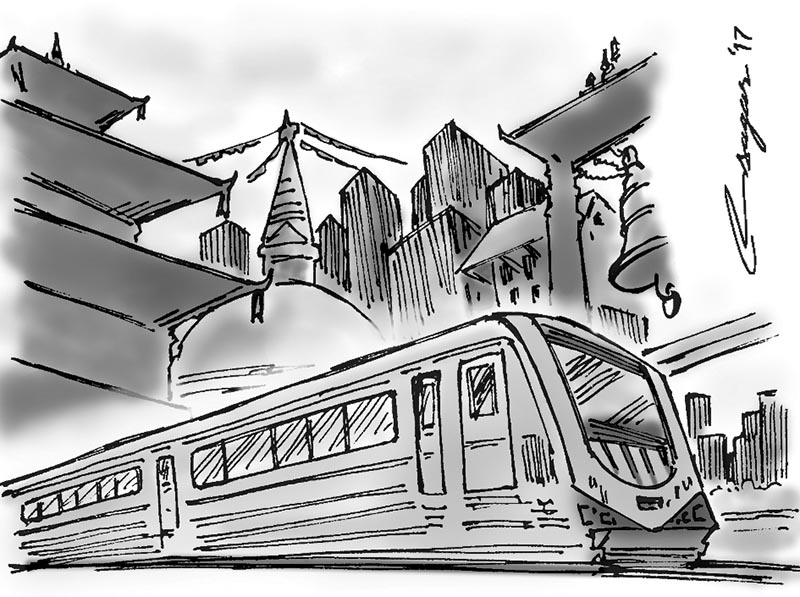Traffic nightmare: Ideal solution
Kilometres of spacious roads have already been built and most are approaching completion. The time is ripe to carve out and implement an extensive BRT system in the valley and aspiration for revolutionizing Kathmandu’s transportation system
All of Kathmandu’s mayoral aspirants’ agendas have one common feature: the need for an urban mass-transit system to ameliorate denizens’ commuting woes. Specifically, they talked about a rail-based urban transport system—metro rails, light rails, and monorails. Someone quipped on social media that someone’s mayoral aspirations would “derail” if it didn’t include “rail”, which explains why aspirants have touted this with an almost religion-like devotion.
But fantasizing an affordable, reliable, frequent, and clean urban transit system is one thing, but engendering it, quite another. That is why, considering Nepal’s limited resources, the urgency in Kathmanduites’ want for a modern transport system, and its existing infrastructure, Bus Rapid Transit (BRT), is the ideal solution for solving the valley’s crippled transportation structure.
BRT, unlike mono-rail or metro-rail, requires very little construction. Simply put, dedicate lanes exclusively for its use; build stations on par with the bus boarding height; purchase scores of high capacity, modern buses (preferably, low-emission articulated buses); and introduce an off-board , advanced ticketing system. Contrast this with the grueling task of metro-rail construction—tunnel digging, elevated structures, underground and surface stations; not to mention its too long construction time in a place anxious for an integrated mass transit solution. Ask Kathmanduites, already fed up with protracted construction projects and a dustbowl of a city it has made, if they’re ready
for another round of heavy-duty construction with no certainty of timely completion, and they will answer with a resounding no. Studies show that for elevated metro-rail systems, it costs between 30-80 million dollars per kilometer; while for underground metro-systems it is around 80-170, depending on the station size, size and orientation of tunnels, and types of locomotives. Looking at these figures, one wonders: how can we make a profit—while remaining affordable—out of such an immense investment? Compare this to the paltry cost of BRT: around 1-15 million dollars per kilometer, depending on the complexity of the project.
Another problem with metro-rail is that the distance between stations must be generous: at least 1.5 kilometers or more, in order to maintain higher travel speeds. This might not be possible in a densely aggregated city like Kathmandu where key junctions or possible metro stations are very close; this would materially increase the construction cost since more stations would incur greater cost. With BRT, keeping stations close, even only a few hundred meters apart would be financially feasible. An additional advantage with this is that more stations will be closer to where commuters work/live, reducing travel time.
Another advantage BRTs have over Metros is flexibility. Not all routes have the same passenger demand; on such routes, it would be unprofitable to operate high capacity low-floor articulated buses; thus an effective “feeder” service can be implemented by operating smaller buses in lesser frequency in less populated areas of the valley where the geography is unfavorable for low floor buses.
Road widening was considered by many as a panacea for traffic congestion, but it has failed people’s expectations. Far from a cure, it was perceived by many as an “invitation” to add more vehicles to empty roads, as evident from the ballooning of automobile sales after road expansions. Simply bulldozing through property to add more lanes without a coherent urban mass-transit policy is a “one-step forward, two-step back” solution. Even a four-lane road, with a concept like BRT, could significantly curb traffic congestion, without the travails of destruction and subsequent pollution.
But even a sustainable and economically feasible concept like BRT has its shortcomings. First, it can only be implemented in roads four lanes or more since one lane should be exclusively segregated for its use. Most secondary roads in the valley are double lane, which makes its implementation impossible among such roads. Second, not all city folk live along or near BRT stations; most live deep inside the valley where even bikes have a hard time fitting, or live on the outskirts of the valley. Thus a significant challenge is providing not only quality BRT service along arteries (major routes), but also reliable standard transport along the veins and capillaries which pervade the valley. This has raised doubts among speculators that BRT system—which also relies on “feeder” service for its efficacy—will not reduce the total number of automobiles plying our roads, and will augment pollution. Despite this, the advantages of BRT over rail-based transit solutions far outweigh its shortcomings. It is economically feasible since the cost of constructing a few kilometers of an underground metro tunnel would suffice for an extensive BRT system.
Presently, Kathmandu is going through a momentous change: denizens have voted in swarms for their local representative with hopes of development. Kilometres of spacious roads have already been built and most are approaching completion. Thus the time is ripe for concerned authorities to carve out and implement an extensive BRT system in the valley—a more sober aspiration for revolutionizing Kathmandu’s transportation system.






